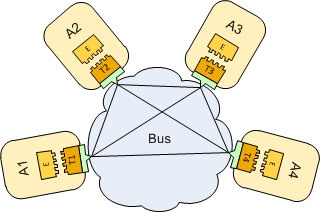Mesh from Pair Connections
You can explicitly assemble a mesh with four vertices. Configure the six pair connections (edges) using four transport definitions:
- T1 listens on port P1.
- T2 listens on port P2 and connects to port P1 on A1’s host computer.
- T3 listens on port P3 and connects to ports P1 on A1’s host computer, and to port P2 on A2’s host computer.
- T4 connects to ports P1 on A1’s host computer, and to port P2 on A2’s host computer, and to port P3 on A3’s host computer.
Notice that all four processes necessarily use different transport definitions to join the bus. It cannot be otherwise, because connection-oriented transport definitions are fragmentary.
Also notice that the four transport definitions (T1 - T4) are each tied to specific host computers. In order to use them, the application process instances (A1 - A4) must run on those host computers, respectively. You can configure this constraint using application instance definitions that match the transport's host parameter.
Related concepts
Copyright © Cloud Software Group, Inc. All rights reserved.

